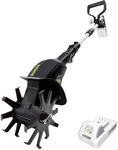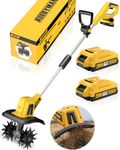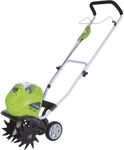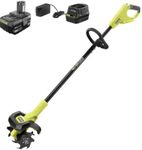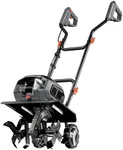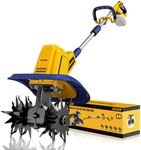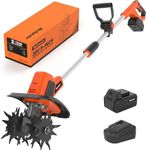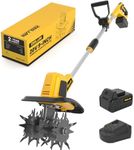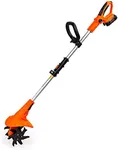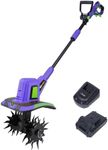Buying Guide for the Best Battery Powered Tillers
Choosing a battery-powered tiller can make gardening and soil preparation much easier, especially if you want a tool that's quieter, lighter, and easier to maintain than gas-powered models. The right tiller for you depends on the size of your garden, the type of soil you have, and how often you plan to use it. Understanding the key features will help you pick a tiller that matches your needs and makes your gardening tasks more efficient and enjoyable.Battery Voltage and CapacityBattery voltage and capacity determine how powerful the tiller is and how long it can run on a single charge. Higher voltage usually means more power, which is helpful for breaking up tough or compacted soil. Capacity, measured in amp-hours (Ah), tells you how long the battery will last before needing a recharge. For small gardens with soft soil, a lower voltage and capacity may be enough, while larger or tougher plots will benefit from higher values. Think about the size of your garden and how long you want to work without stopping to recharge when choosing the right battery specs.
Tilling WidthTilling width is the width of soil the tiller can work in one pass. Wider tillers cover more ground quickly, making them ideal for larger gardens, but they can be harder to maneuver in tight spaces or between rows. Narrower tillers are easier to handle in small gardens or for detailed work around plants. Consider the layout of your garden and whether you need to work in tight spots or want to finish quickly when deciding on the best tilling width for you.
Tilling DepthTilling depth refers to how deep the blades can dig into the soil. Deeper tilling is useful for breaking up hard ground or preparing new beds, while shallow tilling is often enough for mixing in compost or aerating existing beds. Some tillers have adjustable depth settings, which adds flexibility. Think about the type of gardening you do—if you often need to break new ground, a deeper tiller is better, but for regular maintenance, a shallower depth may be sufficient.
Weight and ManeuverabilityThe weight of the tiller affects how easy it is to push and control. Lighter tillers are easier to maneuver, especially in small gardens or for people who may not want to handle heavy equipment. However, heavier tillers can sometimes dig into the soil more effectively. Consider your own strength and the type of terrain you have—if you need to lift or carry the tiller, or if you have a lot of tight spaces, a lighter model may be best.
Ease of Use and MaintenanceBattery-powered tillers are generally easier to start and maintain than gas models, but features like push-button start, ergonomic handles, and easy battery swapping can make a big difference in comfort and convenience. If you want a hassle-free experience, look for features that make operation and maintenance simple. Think about how much effort you want to put into setup and upkeep when choosing your tiller.
Noise LevelOne of the benefits of battery-powered tillers is that they are quieter than gas models, but there can still be differences in noise levels. If you have close neighbors or prefer a quieter gardening experience, consider looking for models that are specifically designed to operate quietly. Your sensitivity to noise and your environment can help guide your choice here.
